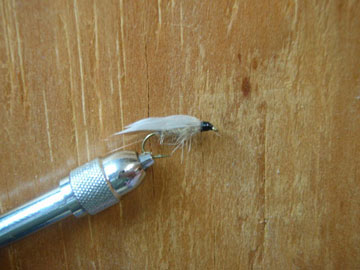FLY OF THE MONTH CONTEST
FEBRARY 2012
Hare's Ear Wet
By Skip MorrisAlso known as the Gold-Ribbed Hare’s Ear Wet, the companion to the ever popular Gold-Ribbed Hare’s Ear Nymph. This wet fly can imitate Mayfly or Caddisfly adults that have drowned or are swimming down to lay their eggs.
Hook- Heavy wire, standard length.
- Mustad= R70, R90, 540
- Tiemco= 760sp, 3769, 9300
or 1x long
- Mustad=39068
- Tiemco=3761
In sizes 16-12
Thread- Orange or black 6/0 or 8/0
Tail- Brown hackle fibers
Rib- Gold oval or narrow flat tinsel.
Body- Hare’s mask (or pre-packaged dubbing), heavier and picked out around the thorax area.
Wing- Natural gray duck quill sections (or hen pheasant wing quill sections)How to Tie
- Debarb hook- place in vice- start thread at about the halfway mark on the shank.
- Tie in the tail about ¾ to a full hook length off from the bend of the hook.
- Tie in the ribbing.
- Dub a body with the rabbit fur (thin on the back and fatter in the thorax area). Reverse wind the ribbing forward- tie off and clip the tag end.
- Using your bodkin or dental floss brush fluff out the thorax area only (front half of body)
- Make a small thread head (cone shape) fat in the back and tapered to the hook eye.
- Grab a pair of matched natural gray duck quills and clip out a piece (from the longer barbs side) the width of your thorax. Match the sections with the concave sides facing inward so they line up perfectly. Size up the wings with your right hand- the tips should be up with the hook bend, then hold the tips with your left hand and the butts with your right. Then hump the wing set slightly by stroking the tips downward. This gives you the desired shape and counteracts the effect the thread will have during tie on. Transfer to your left hand and reestablish the length, using the soft loop or pinch hold (pushing the wings into the thread base) Put thread between your thumb and forefinger then over the back side of the fly then under and back up to capture the wings on the top side slightly to the side of the fly. After a couple more wraps check wings again, if okay, do a few more wraps while always holding the wings if it is not right unwrap and try again. Once okay, build a cone shape head, whip-finish, clip the thread, and you’re done.
Tip- Wings are done the same way as the October 2011 Fly of the Month, The Leadwing Coachman.
That was not a very hard fly to tie was it? So go tie up a couple dozen but save your best one for the fly of the month contest and bring the rest in so Shawn can sell them to other club members.Carl Wuebben


